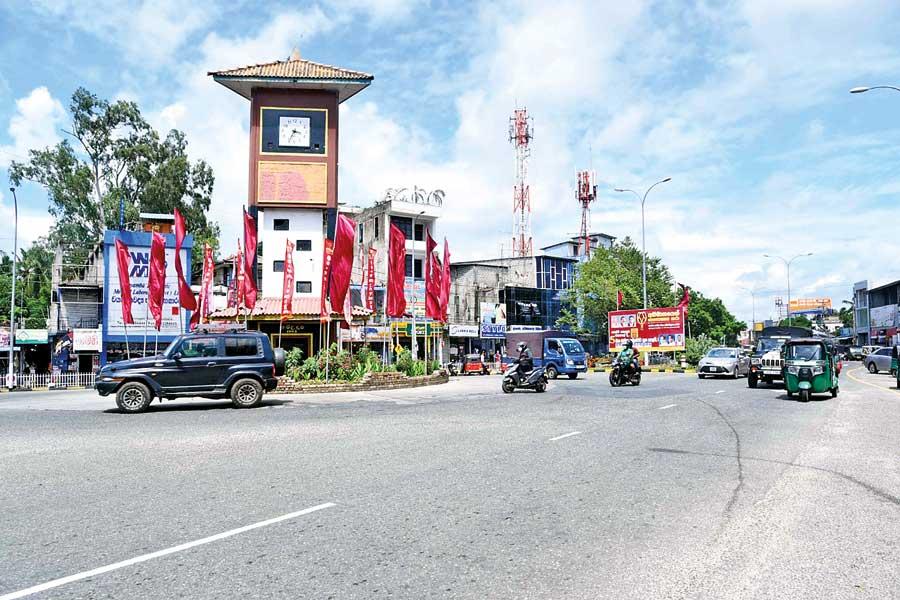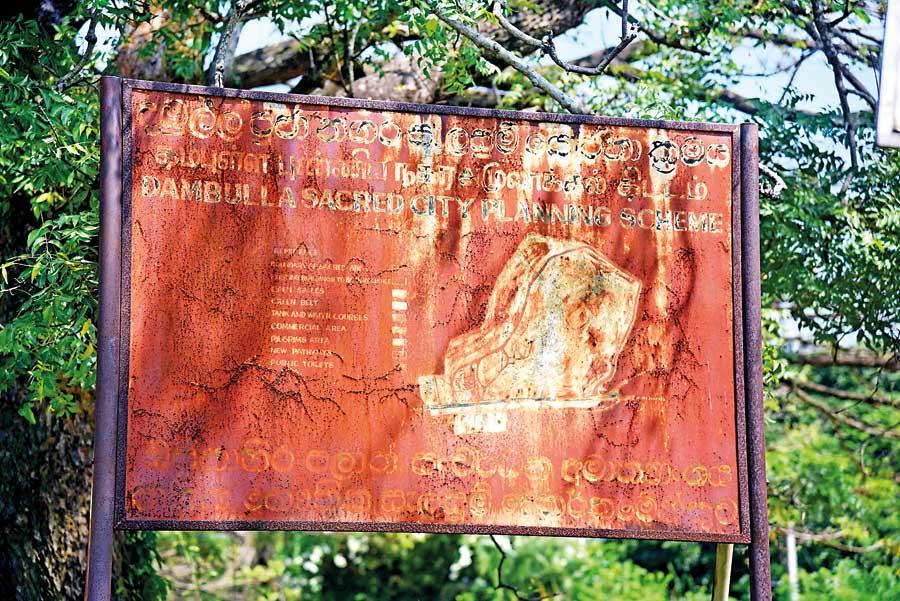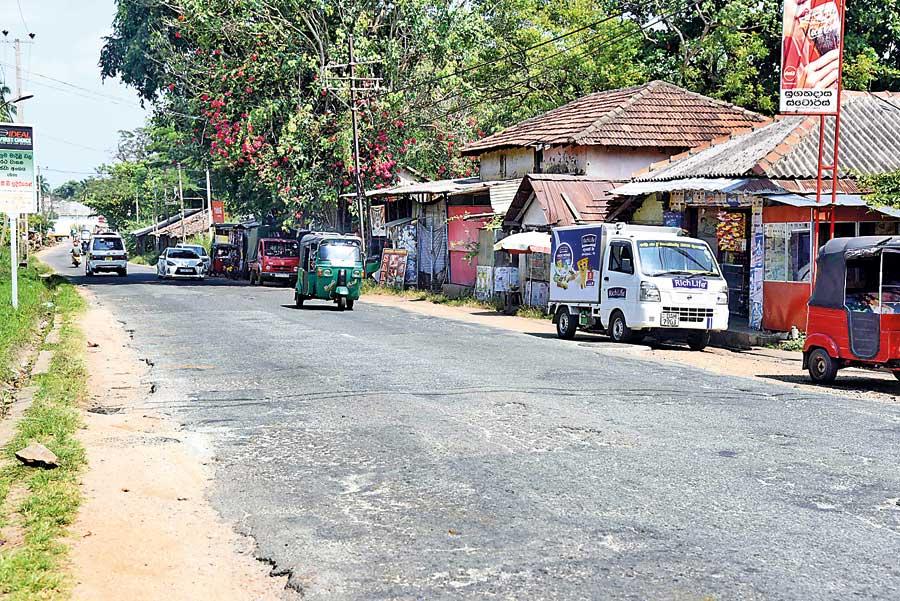Reply To:
Name - Reply Comment

Dambulla town
- The purpose of having sacred area development plans was to provide infrastructure in sacred areas
- Dambulla sacred area development project formally began in 1982 under the ‘Udagam’ concept
- Construction activities of the sacred city are postponed day by day as the Dambulla Municipal Council and Urban Development officers do not pay attention to this matter
Most local politicians are namesake Buddhists and the story about to unfold will provide evidence of that. Plans to build sacred cities began when Ceylon was under British rule. The Pilgrimages Ordinance allowing visitors to sacred places was issued during the same period.
rule. The Pilgrimages Ordinance allowing visitors to sacred places was issued during the same period.
However, this story is not about an incident that took place during the British period. It is about politicians who use religion for politics and are engaged in destroying it. The purpose of having sacred area development plans was to provide infrastructure in sacred areas; mostly visited by pilgrims. Accordingly sanitary facilities, drinking water, rest houses for pilgrims, parking spaces and flower stalls are provisions made by the government. Illuminating areas and preparing landscapes also come under this project. This project is related to the Pilgrimages Ordinance. Public institutes including divisional secretariat, local government authorities, Urban Development Authority (UDA), Road Development Authority (RDA), Electricity Boards in areas where there are sacred places are to take responsibility regarding such projects. In sacred areas except Dambulla politicians support government officers to implement these projects. However politicians instead took steps to halt sacred area development activities in Dambulla.
“As a solution the 40 acres in Aswedduma Pamulayaya land belonging to the Dambulla temple was divided into 40 perches each and divided among 134 families who were to receive alternative lands - Ven. Sumangala Thera"
MP T. B. Thennakoon, representing Dambulla, proposed to Parliament to have a sacred area development plan for Dambulla in 1964. He is the father of Dambulla Electorate Organizer Minister Janaka Bandara Thennakoon who represents Matale district. Maha Nayaka of Rangiri Dambulu Chapter of the Siam Sect, Dr. Inamaluwe Sri Sumangala Thera said that T. B. Thennakoon may have proposed this plan seeing the difficulties encountered by pilgrims visiting Dambulla temple on special Poya days.
 He not only proposed the development project, but planned to build the sacred city and identified boundaries of the sacred area, Sumangala Thera added. However the Dambulla sacred area development project formally began in 1982 under the ‘Udagam’ concept, in Dambulla, which was initiated by the then Prime Minister Ranasinghe Premadasa. Plans were made to initiate the development project under the Urban and Rural Development Department. Gazette no 258/1-81-04-16 and no 137 dated 17.03.1981 declared the Dambulla sacred area and its boundaries. The rest house and Pahala Wewa Road on the A 9 road, Nissanka Road junction, the Police, the road behind the Dambulla National School marked the boundaries. To the South and the West the Idhigollewa culvert, Rangiripaya temple and Meda Pansala marked the boundaries. After determining boundaries, lands under the sacred area plan were taken over by the Government as per Paragraph 38(a) of the Lands Ordinance. This was followed by giving compensation and alternative lands and removing people from the sacred area, according to Ven. Sumangala Thera.
He not only proposed the development project, but planned to build the sacred city and identified boundaries of the sacred area, Sumangala Thera added. However the Dambulla sacred area development project formally began in 1982 under the ‘Udagam’ concept, in Dambulla, which was initiated by the then Prime Minister Ranasinghe Premadasa. Plans were made to initiate the development project under the Urban and Rural Development Department. Gazette no 258/1-81-04-16 and no 137 dated 17.03.1981 declared the Dambulla sacred area and its boundaries. The rest house and Pahala Wewa Road on the A 9 road, Nissanka Road junction, the Police, the road behind the Dambulla National School marked the boundaries. To the South and the West the Idhigollewa culvert, Rangiripaya temple and Meda Pansala marked the boundaries. After determining boundaries, lands under the sacred area plan were taken over by the Government as per Paragraph 38(a) of the Lands Ordinance. This was followed by giving compensation and alternative lands and removing people from the sacred area, according to Ven. Sumangala Thera.
Many issues arose when providing alternative lands and such moves even resulted in weakening the project. The Government gave alternative lands in Atawarahena area which was 25 miles from Dambulla. Wild elephants roam in the area even during the day. A government-owned plot of land spanning 100 acres was chosen, but could not be used due to the presence of wild elephants. People who have been living near the Dambulla temple for a long time have expressed their grievances, Ven. Sumangala Thera added.
“As a solution the 40 acres in Aswedduma Pamulayaya land belonging to the Dambulla temple was divided into 40 perches each and divided among 134 families who were to receive alternative lands,” the thera added. The new village was developed as an ‘Udagama’ and named New Padeniya. Under the sacred area development project temporary stalls located at the temple premises and on each side of the entrance road to the temple were removed. Those stall owners were given 40 perches each from the land behind the Ayurveda hospital belonging to the temple. “Stalls were built and alternative lands were given to people. By 1987 all issues related to alternative lands were solved and compensations were paid off,” Ven. Sumangala Thera added.
"We will complete this project. We are working with Rahula Thera of the Dambulla temple. We have nothing to do with Ven. Sumangala Thera. He has a grudge against us and is trying to take revenge. His accusations are baseless - MP Pramitha Bandara Thennakoon"
However the sacred area development project did not commence as planned. Even though lands were allocated there were political influences hindering the implementation of the project. “Janaka Bandara Thennakoon, who became an MP in 1994, said that his father had requested from him while on his deathbed to start serving the people of Dambulla from where he had stopped,” Ven. Sumangala Thera added. “He (Janaka) said that he had taken to politics after giving up his career at Sri Lanka Police. Dambulla people voted for him with high hopes, but in the end the city was destroyed,” he added.
“When the 40 acres in Aswedduma Pamulayaya was divided among the locals who used to live in the land designated for the sacred area in 1987, 37 lots of 40 perches each were left out for successors’ of families residing in the area. They were under the supervision of public officers. But at present public officers and politicians in the area have illegally sold those lots to outsiders. Janaka Bandara Thennakoon is also behind these underhand deals,” the priest added. “Old buildings, used by people who resided in areas under the sacred area development project, are still there. Politicians in the area have rented these lands, with buildings, to their associates and also granted permission to build permanent buildings in some lands. Instead of implementing the Dambulla sacred area development project politicians and public officers in the area are trying to halt the project,” Sumangala Thera said. He added that those lands were released for public institutes to implement the project, but the political authorities aren’t allowing the takeover of the lands to implement the project.

The plan highlighting the project for the development programme
Unwilling to leave their lands
Construction activities of the sacred city are postponed day by day as the Dambulla Municipal Council and Urban Development officers do not pay attention to this matter. These lands belong to the Dambulla temple. “People have been forcefully settled in lands allocated for the sacred area development project. They are illegal settlers. When taking over lands for the project these residents were given lands and compensations and all matters were solved,” the Thera added. According to the Dambulla city plan, the current settlers will also be given alternative lands. But they refuse to take these lands. Under compensation regulations, the Government planned to pay them 0.5 million rupees each, according to Sumangala Thera. But to obtain the compensation they have no way to prove their residence. They have no document to show their right to obtain compensation. The divisional secretary should interfere to give alternative lands. Even if lands are given they are unwilling to vacate their current lands.
“People who resided close to Makara Thorana were removed and some people received stalls afterwards. They have caused problems by refusing to leave their lands despite receiving alternative lands. To find solutions to their problems the sacred area development project should be accelerated. With the construction of the alternative four lane A9 Road, they will find solutions to most of their present problems. If the plan can be implemented soon, all these problems will be solved,” Ven. Sumangala Thera added.
“But Minister Janaka is asking illegal settlers not to leave the lands and obtain compensation. Even several public officers support him,” he added.
Bars and political influence
Janaka Bandara Thennakoon who came to fulfill his father’s wishes started off by giving permission to a moonshine trader in Dambulla instead of establishing the sacred city. He also supported promoting the business of illegal liquor. They were famous in Dambulla as ‘Janaka packets’. When informed, former President Chandrika Kumaratunga sealed the bar. However since 1994, 14 bars have been opened in Dambulla under political influence.
As a result the sacred area development project, which was planned in 1964, was postponed for 58 years. “Janaka Bandara Thennakoon attempted to halt the sacred area project in Kandalama junction by sending a letter to the current president who was then the secretary to the Urban Development Authority in 2011. He also attempted to sell lands and buildings of people; whose lands were taken over by the project with the help of local politicians and public officers,” said Ven.Sumangala Thera who added that he had in his possession evidence to prove these facts. “He (Janaka) even created disputes among religious and ethnic groups by building a prayer hut for Muslims in Dambulla in the sacred area,” said the Thera.
“People who obtained compensation once have applied for compensation again. Now we have planned to pay compensation or give alternative lands to people who got nothing. Dambulla sacred area development project will begin this year - UDA Chairman Maj. Gen. Udaya Nanayakkara"
However, according to a request made by the then President Mahinda Rajapaksa in 2011 and on the instructions of UDA Secretary Gotabaya Rajapaksa the Dambulla sacred area development activities began in 2014 under the gazette no 1849/16 dated 12.02.2014 signed by UDA Chairman Nimal Perera on the development plan for urban areas in Dambulla; which included the Dambulla sacred area development plan. However the project was again halted with the change of government in 2015. When requests were made to implement the sacred area project during the Yahapalana Government a minister refused it claiming his Government could not continue with Mahinda Rajapaksa’s development activities and Minister Janaka also opposed it,” recalled Ven. Sumangala Thera.
When contacted, Dambulla Mayor Jaliya Hemantha Opatha refused to talk at the mention of the writer’s name.
Speaking regarding the delays in the sacred area project after removing people and paying compensation for lands acquired, Dambulla Divisional Secretary Piyal Jayasooriya said lands under the divisional secretariat have been taken over by the UDA. “We will not pay compensation twice for any land. There are people who have been living in these lands for a long time. They are refusing to leave the lands claiming that the compensation was not sufficient. Many issues arose when paying compensation for these lands. They are under the Temple and Dewala Lands Act. The Attorney-General when interpreting what’s stated in the Temple and Dewala Lands Act has said to refuse payment of compensation for lands. Steps will be taken considering that aspect. Even if plans were made to give them alternative lands, there are problems. They have to be solved for this project to continue.” Jayasooriya added.
“We will not pay compensation twice for any land. There are people who have been living in these lands for a long time. They are refusing to leave the lands claiming that the compensation was not sufficient. Many issues arose when paying compensation for
these lands, - Dambulla Divisional Secretary Piyal Jayasooriya"
Speaking on behalf of Minister Janaka Bandara Thennakoon, who was not in the best of health, MP Pramitha Bandara Thennakoon said that the project is underway, but as issues have arisen regarding land acquisition, alternative lands and compensation, the project will be continued after finding solutions to them. “We will complete this project. We are working with Rahula Thera of the Dambulla temple. We have nothing to do with Ven. Sumangala Thera. He has a grudge against us and is trying to take revenge. His accusations are baseless. Our answer is ‘Nahi Verena Verani’ (hatred cannot be appeased by hatred), he added.
UDA Chairman Maj. Gen. Udaya Nanayakkara said that the Dambulla sacred area development project was given to the UDA by a gazette in 2014. “We then took steps to initiate the project. There were 200 families. They were employed in the economic centre. Some of them were paid compensation and some were not. Some have sub families. We planned to build houses for them in 5 ½ acres in Polwatta area. But that too is not complete. People who obtained compensation once have applied for compensation again. Now we have planned to pay compensation or give alternative lands to people who got nothing. Dambulla sacred area development project will begin this year.” Maj. Gen. Nanayakkara added.
(Pic by Samantha Perera)

The land belonging to the sacred area